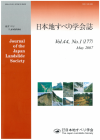All issues

Volume 44 (2007)
- Issue 6 Pages 339-
- Issue 5 Pages 281-
- Issue 4 Pages 205-
- Issue 3 Pages 145-
- Issue 2 Pages 71-
- Issue 1 Pages 1-
Predecessor
Volume 44, Issue 3
Displaying 1-6 of 6 articles from this issue
- |<
- <
- 1
- >
- >|
Original articles
-
Akihiko WAKAI, Keizo UGAI, Atsuo ONOUE, Kunihiro HIGUCHI, Seiichiro KU ...2007 Volume 44 Issue 3 Pages 145-155
Published: 2007
Released on J-STAGE: February 29, 2008
JOURNAL FREE ACCESSMany landslides in mountain area occurred during 2004 Mid Niigata Prefecture Earthquake in Japan. Numerical simulation for the collapse of a dip slope by the 2-D dynamic elasto-plastic finite element method is reported. To simulate such a catastrophic failure, the strain-softening characteristics under cyclic loading for the thin sand seam within the bedding plane were investigated, based on the cyclic direct shear tests of undisturbed block samples. As a result, the observed phenomena could be simulated well by the analysis and it was suggested that a long distance traveling failure was induced by the strain-softening behavior of the bedding plane.View full abstractDownload PDF (1436K) -
Seiichi GIBO, Shinya NAKAMURA, Keizo SASAKI, Tingning ZHAO2007 Volume 44 Issue 3 Pages 156-161
Published: 2007
Released on J-STAGE: February 29, 2008
JOURNAL FREE ACCESSUtilizing the strength parameter from the shearing test, the slide mechanisms of the Erdaocha landslide, which located in Loess plateau, China, were discussed. The slip surface was found in the vicinity of the interface between loess and shale. The fully-softened and residual strengths of soil samples from the slip surface were cleared by the ring shear test, and the groundwater level at the time when the landslide will be reactivated was calculated through the stability analysis. Next, it was revealed that the mobilization of the residual strength which reduces the average shear strength along the slip surface was indispensable for the primary stage of the landslide.View full abstractDownload PDF (958K) -
Taishi ABE, Hisataka TANO2007 Volume 44 Issue 3 Pages 162-170
Published: 2007
Released on J-STAGE: February 29, 2008
JOURNAL FREE ACCESSThe authors made a system consisting of monitoring such as AE counter and handy laser distance meter. When the behavior of landslide is to be assessed by some monitoring system, the system must be simple and cheap to implement. The AE system used in this study is in focus of AE event rate count only and was applied to two landslide areas. At site A, a tunnel was progressively damaged by the landslide movement. We could recognize the change of the convergence using by laser distance meter with accuracy 1.5 millimeter. A delayed time between rainfalls with AE activity was observed each site. At site B, we consider the relationship of enlargement of landslide from the slide of local section at main scarp. The pipe strain gauge (No. 4) started accumulating after the increase of the AE count of the portable AE counting system.View full abstractDownload PDF (1917K)
Technical reports
-
Satoshi NAITO, Kazuhiro NODA, Hiroshi KAWAKAMI2007 Volume 44 Issue 3 Pages 171-174
Published: 2007
Released on J-STAGE: February 29, 2008
JOURNAL FREE ACCESSDownload PDF (343K) -
Masuo KANDA, Noboru UGATA, Katsuhiko ARAI, Hideaki NAKANO2007 Volume 44 Issue 3 Pages 175-184
Published: 2007
Released on J-STAGE: February 29, 2008
JOURNAL FREE ACCESSDownload PDF (2016K) -
Takeyuki UEKI2007 Volume 44 Issue 3 Pages 185-187
Published: 2007
Released on J-STAGE: February 29, 2008
JOURNAL FREE ACCESSDownload PDF (500K)
- |<
- <
- 1
- >
- >|